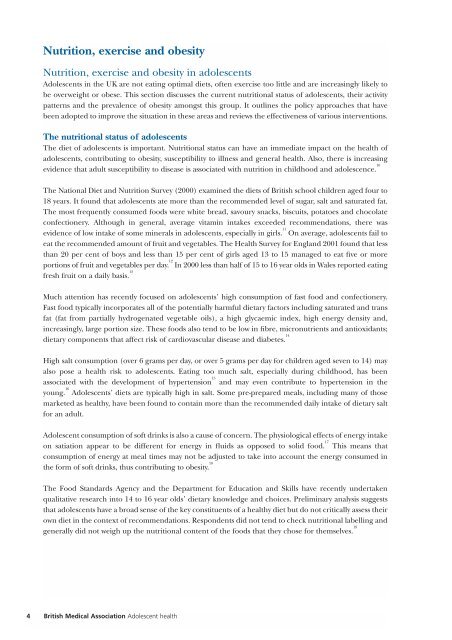Alcohol misuse: tackling the UK epidemic - London
Alcohol misuse: tackling the UK epidemic - London
Alcohol misuse: tackling the UK epidemic - London
You also want an ePaper? Increase the reach of your titles
YUMPU automatically turns print PDFs into web optimized ePapers that Google loves.
4<br />
Nutrition, exercise and obesity<br />
Nutrition, exercise and obesity in adolescents<br />
Adolescents in <strong>the</strong> <strong>UK</strong> are not eating optimal diets, often exercise too little and are increasingly likely to<br />
be overweight or obese. This section discusses <strong>the</strong> current nutritional status of adolescents, <strong>the</strong>ir activity<br />
patterns and <strong>the</strong> prevalence of obesity amongst this group. It outlines <strong>the</strong> policy approaches that have<br />
been adopted to improve <strong>the</strong> situation in <strong>the</strong>se areas and reviews <strong>the</strong> effectiveness of various interventions.<br />
The nutritional status of adolescents<br />
The diet of adolescents is important. Nutritional status can have an immediate impact on <strong>the</strong> health of<br />
adolescents, contributing to obesity, susceptibility to illness and general health. Also, <strong>the</strong>re is increasing<br />
evidence that adult susceptibility to disease is associated with nutrition in childhood and adolescence. 10<br />
The National Diet and Nutrition Survey (2000) examined <strong>the</strong> diets of British school children aged four to<br />
18 years. It found that adolescents ate more than <strong>the</strong> recommended level of sugar, salt and saturated fat.<br />
The most frequently consumed foods were white bread, savoury snacks, biscuits, potatoes and chocolate<br />
confectionery. Although in general, average vitamin intakes exceeded recommendations, <strong>the</strong>re was<br />
evidence of low intake of some minerals in adolescents, especially in girls. 11<br />
On average, adolescents fail to<br />
eat <strong>the</strong> recommended amount of fruit and vegetables. The Health Survey for England 2001 found that less<br />
than 20 per cent of boys and less than 15 per cent of girls aged 13 to 15 managed to eat five or more<br />
portions of fruit and vegetables per day. 12<br />
In 2000 less than half of 15 to 16 year olds in Wales reported eating<br />
fresh fruit on a daily basis. 13<br />
Much attention has recently focused on adolescents’ high consumption of fast food and confectionery.<br />
Fast food typically incorporates all of <strong>the</strong> potentially harmful dietary factors including saturated and trans<br />
fat (fat from partially hydrogenated vegetable oils), a high glycaemic index, high energy density and,<br />
increasingly, large portion size. These foods also tend to be low in fibre, micronutrients and antioxidants;<br />
dietary components that affect risk of cardiovascular disease and diabetes. 14<br />
High salt consumption (over 6 grams per day, or over 5 grams per day for children aged seven to 14) may<br />
also pose a health risk to adolescents. Eating too much salt, especially during childhood, has been<br />
associated with <strong>the</strong> development of hypertension 15<br />
and may even contribute to hypertension in <strong>the</strong><br />
young. 16<br />
Adolescents’ diets are typically high in salt. Some pre-prepared meals, including many of those<br />
marketed as healthy, have been found to contain more than <strong>the</strong> recommended daily intake of dietary salt<br />
for an adult.<br />
Adolescent consumption of soft drinks is also a cause of concern. The physiological effects of energy intake<br />
on satiation appear to be different for energy in fluids as opposed to solid food. 17<br />
This means that<br />
consumption of energy at meal times may not be adjusted to take into account <strong>the</strong> energy consumed in<br />
<strong>the</strong> form of soft drinks, thus contributing to obesity. 18<br />
The Food Standards Agency and <strong>the</strong> Department for Education and Skills have recently undertaken<br />
qualitative research into 14 to 16 year olds’ dietary knowledge and choices. Preliminary analysis suggests<br />
that adolescents have a broad sense of <strong>the</strong> key constituents of a healthy diet but do not critically assess <strong>the</strong>ir<br />
own diet in <strong>the</strong> context of recommendations. Respondents did not tend to check nutritional labelling and<br />
generally did not weigh up <strong>the</strong> nutritional content of <strong>the</strong> foods that <strong>the</strong>y chose for <strong>the</strong>mselves. 19<br />
British Medical Association Adolescent health
















